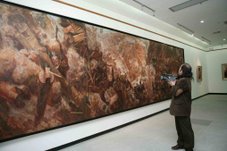 The reliable Scotman.com from -- where else? -- Scotland, has the latest update on the red hot market for modern Asian artwork:
The reliable Scotman.com from -- where else? -- Scotland, has the latest update on the red hot market for modern Asian artwork:"Art collectors, dealers and auction houses are increasingly looking east for inspiration and investment opportunities, eying the rising stars of Asian painting as well as the region's super-rich patrons.Everyone's favorite example de jour is mentioned -- Zhang Xiaogang's bleak "Tiananmen Square." Originally estimated to sell at Cristy's Hong Kong auction last autumn for $257,069 to $385,604, the winning bidder actually paid $2.3 million plus, one assumes, the usually hefty buyer's premium.
* * *
"Asian art's ascendancy in recent years has been spectacular, with contemporary artists seeing prices for their work soar."
It's no knock against Zhang's painting to say that someone got taken, badly. Conning the rich into over-paying for the latest fashion in the art world is a marketing ploy as old and disreputable as any stock swindle on Wall Street.

Now, we are told, the market already is tiring of Chinese modernists and is moving on to India. Also last fall, a Tyeb Mehta acrylic, "Mahishasura," sold for more than $1.5 million.
A gallery owner is quoted as saying --
"There were some Western collectors who had got into contemporary Chinese art which has seen a gigantic runup in the last year or two.It won't be long before India's artists are abandoned, too, and auction houses start hyping artists from some other clime like Yemen or maybe Tierra del Fuego. Sounds like typical stock churning, doesn't it? Art collecting as the equivalent of a Kwakiutl potlatch, where the rich throw their money away to prove just how rich they are."Some were saying 'What's next?', and contemporary Indian art seems to represent a certain value opportunity and creatively a certain strength."
The whole business reminds us of critic Peter Schjeldahl's pointed observation in The New Yorker not long ago. Speaking of a U.S. artist who enjoys a certain momentary popularity in New York, he wrote:
"Great artists work from and for history, where no one lives. Kiki Smith, the subject of a tangy retrospective at the Whitney ... is a major figure ... who makes minor art."The real trick is to collect "major art" that you like and pay no attention to the reputation-at-the-moment of the artist.
